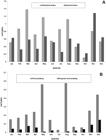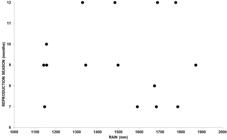Bats can be monoestrous or polyestrous, and seasonal or non-seasonal in their reproductive patterns. The strategy adopted by each species or population depends on the regional climate. The objective this study was to analyze reproductive data of Sturnira lilium from long-term sampling carried out in several sites in Rio de Janeiro states, southeastern Brazil. We carried out sampling in 42 sites (with altitudes ranging from sea level to 1300 m a.s.l.) from May 1989 to December 2011. In total, we obtained 2602 captures of S. lilium: 1242 captures of adult females, 1225 captures of adult males, and 136 captures of subadults. The sex ratio was 0.99 males: 1 female. The reproductive season varied from eight to twelve months a year, and it was not related to the total accumulated rainfall. Sturnira lilium have continuously polyestrous reproduction with postpartum estrus and pregnant females can be observed in all months except July. In the present study, the highest proportions of pregnant females were observed in the months with the highest rainfall.
seasonality; reproductive season; rain influence; Atlantic Forest; Rio de Janeiro

 Thumbnail
Thumbnail
 Thumbnail
Thumbnail
 Thumbnail
Thumbnail
 Thumbnail
Thumbnail
 Thumbnail
Thumbnail
 Thumbnail
Thumbnail





